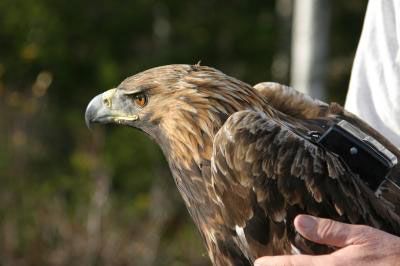
Eye-in-the-Sky Aims to Keep Eagles Safe from Wind Farms

Golden eagles are now being tracked by satellite to learn how these raptors use the landscape, research that could help better place wind farms that can harm these majestic predators.
Wind farms harness the wind's energy to cleanly generate electricity. However, one concern is that the spinning rotors of wind turbines could inadvertently kill wildlife, thus potentially damaging the environment for miles around. This is especially a concern with birds such as the golden eagle (Aquila chrysaetos), which is classified as near-threatened in Sweden.
To learn more about how far the eagles fly and how they move about the environment, scientists are trapping adult golden eagles in northern Sweden and fitting them with satellite transmitters.
"Hopefully we can identify the golden eagles' favorite habitats," said project manager Tim Hipkiss at the Swedish University of Agricultural Sciences. "When we've done that we can see where wind farms can be established without disturbing the eagles."
Expert aide
The researchers have recruited the aid of experts from the United States, where it is more common to trap golden eagles as part of conservation projects. Still, "the golden eagles in the U.S. tend to be in deserts and mountains, very different from the coniferous forests here," Hipkiss said. "Not many people know how these eagles move about in their territory in forest environments."
The satellite transmitters emit a radio signal once an hour during the daytime, letting scientists know where the eagles are. So far, the scientists have fitted six adult eagles and five nestlings with transmitters, with a goal of 20 adults from 10 territories half where wind farms are planned, half without.
Sign up for the Live Science daily newsletter now
Get the world’s most fascinating discoveries delivered straight to your inbox.
"Trapping adult golden eagles alive has never been done before in Sweden, and probably nowhere else in Europe," Hipkiss said.
To entrap the adults, scientists place out carrion a few weeks in advance as bait. The U.S. experts then conceal a net trap at those sites and conceal themselves a short distance away in camouflaged shelters or "hides."
"Then you just have to wait patiently," Hipkiss said. "When they see the eagle standing in the right place, they push a button and release the net, which isn't very big, just about 1.5 meters (5 feet) in diameter."
Risky endeavor
Attaching transmitters onto two-month-old nestlings is relatively easy, since they can be reached in their nests.
"We take the opportunity when the parents are not around," Hipkiss said. "It is exciting enough to climb 10 meters (33 feet) up a pine tree to fetch an angry juvenile bird."
However, fitting the satellite transmitter onto the adults is a risky, half-hour-long proposition. A full-grown eagle can weigh up to 13 pounds (6 kilograms) and lash out with dangerous claws. To calm the raptors down, the kind of hoods used with falcons are fitted onto the eagles, and their talons are temporarily secured with tape to prevent them from hurting others or themselves.
"One of the guys did get his hand injured, a deep scratch that had to get seen by the doctor, but he's all right now, nothing serious," Hipkiss said.
Success story
The transmitters sit in place on the raptors like a comfortable backpack, and the birds have no problems flying with them, Hipkiss said. The scientists have already discovered that the eagles fly farther than previously thought.
"People had thought the adults maybe flew up to 5 kilometers (3 miles) on a day-to-day basis, but now we're already seeing that 10 kilometers (6 miles) is possible," Hipkiss told OurAmazingPlanet.
The plan now is for the adult birds to carry their transmitter for five years and the juveniles to carry theirs for two years.
"So far the project looks successful," Hipkiss said. "It's really great to see that this works."












